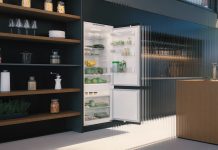Eliminating odours? It is no longer sufficient. Today domestic hood producers are requested to make a further effort to create products with different and more sophisticated performance characteristics. Without neglecting sustainability.

Performing, multitasking, silent, with a fine look or on the contrary readily foldable away: suction systems are increasingly challenged in terms of performances and aesthetics.
Versatility, customization possibility or range depth are only some of the essential features that each proposal is expected to satisfy. Today, however, a new parameter is introduced into the value scale and can become an important discriminant in the choice of the household appliance by end users: energy efficiency has been for a long time one of the issues at which hood manufacturers are working but the introduction of the energy label provided for January of the current year has undoubtedly speeded up the processes of research and experimentation of new “greener and greener” solutions.
Concerning this, several are the aspects on which companies are focusing their attention and they are interested not only in the finished product but very often in the whole productive cycle.
Filters, motors, lighting system and more in general the entire project, then also shape and used materials, must be thought in view of maximizing the suction result while using the least energy quantity. In other words, the hood is becoming a complex element because called to perform some determinate functions, including the capability of dialoguing with other household appliances and smart devices hosted in the kitchen, for a smarter and smarter home, user- and eco-friendly.
Multitasking functions and interaction
Hoods are smart multitasking objects because, besides the primary suction function, they simultaneously perform other activities. At the beginning, lighting was introduced as secondary function and then others gradually joined and completed an equipment that has undoubtedly raised the hood to the rank of one of the absolute kitchen protagonists.

Already in 2005 Elica had presented the first lamp-hoods that could be installed in the middle of the room, maybe above the isle, which became luxury chandeliers or real furniture objects. Today, given up the wish of exhibiting the element, the most interesting solutions allow fulfilling more tasks in a small space because on one hand the technological evolution has permitted to reduce the overall dimensions of many components, on the other hand the narrower and narrower sizes of kitchens have unavoidably requested smart and flexible space-saving solutions.
It is what happens for instance in the hoods of the Cast line, designed by Patricia Urquiola for Beko, described by Michela Lucchesini, Marketing Manager Beko Italy, as follows “Cast is a unique example of perfect integration of two primary functions in the kitchen: the standard suction above the hobs and the opportunity of relying on a cabinet to lay cookbooks, phone, tablet, from which we are perhaps drawing inspiration to cook or where tools can simply rest. The hood integrates then the lighting system, always precious in the cooking zone”.
Interesting also the solution proposed by the hand-made German brand Gutmann, today part of Elica Group. The hood Conecta is a versatile and modern proposal in line with the requirements of the contemporaneous living. In addition to the double lighting system composed by environment light and LED functional lighting, the hood houses in fact an integrated base for the charging and the playback of iphone and ipod.

More functions, then, but also a simple and intuitive use to clear the idea that forefront household appliances are complex machines and to study in-depth the issue of the man-machine interaction, as underlined by Fabrizio Crisà, Elica designer heading the design team inside the company: “We work hard also on the concept of automation, of man-machine interaction. The most iconic hood is Feel, made of glass, activated by a hand touch. Feel corresponds to the principles of the interactive design with e-motion, the system that electronically operates the suction and the lighting by grazing the big panels installed on the front side. The movement of the elements determines the activation of functions and the sizes of the panel surfaces correspond to the quantities of steam to be sucked, while the upper panel operates the Led light”.
Dialogue that does not follow only a unilateral direction from the man towards the machine. The matter of the connected house and of the innovative and aware use of household appliances is mainly accomplished in terms of consumptions and energy saving, of interconnection among the elements themselves, in the capability of each of them of receiving and transmitting information and consequently adjusting their operation automatically.
“One of the aspects on which Novy focuses its research activity – explains Katrien Van Hecke, marketing and communication manager of the company – is the connection among products: the InTouch system, for instance, allows checking the hood from the hob by “linking” two products that are generally used at the same time. The InTouch system is integrated into the hob and therefore end-users will not need a remote control any longer. This segment is very interesting for Novy and matter of intense studies: during the last exhibition Interieur 2014 we presented a prototype that works just in this way: a design hood that through a set of sensors can calibrate its power and detect danger situations”.
Absence aesthetics
In the recent past, the hood was increasingly developed as furnishing object, as design element to be shown inside the kitchen. We have tried for a long time to develop products able to arouse emotions, becoming objects of desire and especially timeless. It is not easy to identify a predominant formal trend over the last few years, it was a succession of rigid and smooth shapes carefully dosed, of sophisticated details, of refined surfaces and lively colours. An outstanding identity and a strong personality that more and more often identify the most iconic hoods installed above an isle in the middle of the kitchen or of the living zone, instead of being wall-mounted.
The used materials range from the more traditional steel and glass to new materials with shapes more easily modelled and more suitable for proposing unusual colours and refined finishes.
Further adds Crisà for Elica: “We are always looking for new materials with suitable performances for our use, technologies and machining processes that give new blood to materials that we have always used. Concerning colours, white and black, as well as steel, rank first and, besides them, soft colours and pastels. The last ranges are characterized by opaque finishes, mirror-polished steels and etched or shiny glasses with coloured silk-screening. Concerning materials and shapes, our research is constantly going on, also because they must withstand high temperatures; this year at Ftk 2014 we presented several innovative hoods from this point of view: Ye, for instance, is the first hood made of Cristalplant, a solid-surface material obtained by injection that has allowed us to mould a new complex shape, with smooth lines, a sculpture to be observed at 360° with a double directed suction source”.

From the formal point of view, still Elica provides the indication of a more and more frequent preference of fold-away hoods, able to hide inside cabinets, for a kitchen without a break. A trend that must not result in an impoverishment of the product, on the contrary it must give birth to even greater attention to details just because only they can signal the presence of the hood, especially when it is not on. Integrated and essential products, then, but not damaging functions and performances.
The same wavelength is shared also by Miele, as we can deduce from the words by Carlo Busolin, Senior Product Manager Kitchen Appliances “The trend is certainly the “fold-away”, since environments are more and more compact, with the living zone together with the kitchen. Forefront solutions from the technological point of view, like the powered fold-away hoods: the new DA 3660 and DA 3690 are arousing lively interest, due to their characteristic of being energy-efficient and actually unique on the market. As a matter of fact, they open, close, operate and adjust exclusively with the underlying hob in function, permitting also to save consumptions and increasing efficiency”.

Today, fold-away solutions are the most demanded for Novy, too: “The current trend is certainly to hide the hood as much as possible: in the ceiling, in the pieces of furniture and in the hob. Novy has already various models that meet this trend and is working to innovate further. From a purely aesthetic point of view, steel remains the most popular choice, even if the introduction of materials like glass or others, more unusual, is no more an occasional choice”.
A sophisticated design, based on empty spaces and absences, an uncompromised minimalism that matches in very innovative way the clean and linear style of contemporaneous kitchens.
Andrea Poser, Marketing Manager of Falmec, expresses his remarks on the theme, too, describing the ceiling hood Eclisse as follows: “It is a new interpretation of the fold-away integrated hood that fully frees the space above the hob and is directly installed flushed with the ceiling from where it performs its lighting and suction functions. Rational and elegant, it is constituted by a steel structure with white finish and by a tempered glass panel with two side glass bands for the Led lighting assuring an efficient lighting of the hob. When used, the central body comes out from the ceiling, uncovering a wide filtering zone, and then it returns to its seat once accomplished its function”.
No matter whether they are fold-away or well visible, with essential or more complex shapes, hoods more and more often must come to terms with the integration, also from the formal point of view, with the other household appliances.
Shapes, lines and stylish details of hoods must speak a common language to match ovens, hobs and all other household appliances generally equipping the kitchen. A very important coordinated aesthetics for Gaggenau “A kitchen with innovative design calls for individual, constantly new suction solutions. To satisfy the ever-growing demand, we have notably widened our range – explains Sven Schnee, Head of the company – Likewise what occurred for ovens, hobs and refrigeration, the principles of essentiality and reliability that have characterized the 400 and 200 series, are introduced also for suction appliances of different typologies. Isle-and wall-type suction centres AI/AW 442 complete the 400 series that includes the telescopic hob hood AL 400, the hob suction unit VL 414 and the ceiling suction system AC 402”.
Silent and sustainable
We have talked about shape and performance, we are going to see now how the hood element and its operation can notably influence the domestic life, the comfort and the quality of environments.
The incidence of the hood element in everyday life is obviously expressed by the suction quality as well as by the acoustic pollution and the energy saving. If silence is in fact a consolidated value in high-end proposals, the energy label regulation can undoubtedly increase everybody’s awareness of the environmental issues, in particular of the energy consumption reduction.
Still Crisà for Elica: “The attention paid to the acoustic pollution is certainly one of our strong points, lots of our hoods are based on the EDS (Elica Deep Silence) technology, an exclusive patent by Elica that makes them very silent. All the new products presented during the last edition of Eurocucina are already in A class and the target is the inauguration of 2015 with new products in A+ class, the highest that can be declared. At the same time we are also working on all hoods already in the catalogue for the energy class upgrading”.
Falmec’s research concentrated on the silence issue, too, as Andrea Poser explains “Taking the suction efficiency for granted, two were the gripes that were usually addressed to hoods; the first for being noisy, the second for not filtering the air if used in filtering version. Over the last few years, we have implemented two important projects just aimed at solving these old problems. These gave birth to the Silence-NRS and E.ion collection. The first, thanks to studies on fluid dynamics and on materials has allowed us to make the airflow as “simple” as possible, eliminating turbulences and noise. The result is a family of products that we cannot actually hear. The second is a product range that, using the dipolar controlled ionization, allows a domestic air purification that reaches 95%, without problems of tubes and relative energy costs and wastes”.

Carlo Busolin from Miele tries to trace a synthesis and to indicate the priorities in the scale of values: “Functions certainly remain the main criterion in the design and production of this element for the kitchen. Even more starting from the beginning of the year, due to the introduction of new energy labels that will certainly generate a new awareness of characteristics and consumptions. Besides, attention must be paid to aesthetics and easy assembly and therefore the new projects will try to combine all these elements. Miele has adopted the energy labels since the beginning, being able to propose an immediately competitive offer and it strives to propose forefront energy-efficient solutions in line with consumers’ growing awareness.”.
Novy is interested in the matter, too, and it has developed a range of specific products with “green” characteristics that it will try to transfer to all models “Besides equipping all strategic models with Led lights, we have prearranged each model with a technological core (the motor) able to achieve the best result (A and A+). We have not stopped here: we have in fact introduced a range of ECO-friendly products. In addition to the type of lights and to the motor power, there are other aspects that can guide customers in the hood choice: recycling, the right installation, the efficiency in sucking fumes. These aspects are not covered in the label and so Novy has decided to work harder to provide possible customers with more information before the purchase”.

The silence and efficiency pair is irremissible also for Gaggenau “They are combined with durable silent external motor groups, maintenance-free, thanks to the BLDC technique that grants also lower energy consumption. Such modules can be installed both in the kitchen and outside, thus reducing the noise in the suction place and permitting to save space. All models can operate with recirculation or exhaust, with a delivery up to 970 m³/h. The recirculation module is equipped with efficient active-carbon filters that grant a noise reduction that equals exhaust models’. It is possible to clean fat filters in the dishwasher without problems”.

The motor is undoubtedly one of the most important components from this point of view because, besides being the beating heart of the hood, is the element that can really establish reference standards and parameters also in the energy matter, as reminds Rossano Bartolini, Head of Sales & Marketing of Best.
“Being producers of motors, we take care of this issue and we faced it in the company several years ago, in the past with the three-phase system and today with the new high-efficiency motors that, in combination with a Led lighting, will be massively offered on several models of the 2015 catalogue and that permit to reach the A energy class. In addition, we will offer a series of hoods equipped with brushless motors that grant an energy consumption decrease up to 80% in comparison with standard motors, attaining an A+ efficiency class and in line with what provided for by the regulation for the incoming years, with the progressive rising of the highest energy class”.

Very interesting, to complete the theme of the energy saving and of the introduction of the energy label, the remarks by Andrea Poser from Falmec “We have worked in time for the adoption, in the almost totality of our range, of a very efficient motor, in A class. It is however worth underlining that the regulation does not take absolutely into account the waste caused by the emission of the domestic air outside. In winter, for instance, if the hood is connected with the exterior and then in sucking version, the higher energy consumption is due, rather than to the energy absorption of motor and lighting, to the waste of hot air that we dispose outside, with the consequence of having to heat again the same volume. That is why, besides a necessary attention to the efficiency of the household appliance in itself, we must also consider the waste that the air ejection outside involves. For this reason, we have been proposing for some years the E.ion collection, a series of only filtering products that, thanks to the ionization technology, grant anyway a real air purification”.
They are not the only one who reason in-depth on the waste issue; Novy is very sensitive to the recycling matter, too. “Another matter on which we concentrate our efforts is recycling. In a scenario in which the energy consumptions of dwellings are the focus of the interest, this is a concept on which we have decided investing: the monoblock filter grants the odour absorption while the recirculation hood sends again the filtered air inside the kitchen, thus granting its heating!”.




